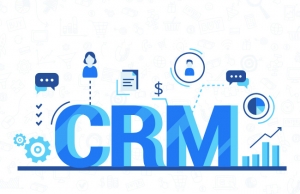عرض العناصر حسب علامة : ادارة علاقات العملاء
الإثنين, 18 يوليو 2022 11:26
أنظمة إدارة علاقات العملاء CRM
في عالم يتوقع فيه العملاء ان يجدوا الخدمة في أي مكان وزمان، تحتاج الشركات إلى أنظمة وعمليات إدارة علاقات العملاء فعالة (CRM) للبقاء في الصدارة ولكن كيف يمكن ذلك؟
نشر في
موضوعات متنوعة
موسومة تحت
الأحد, 17 يوليو 2022 12:34
كيف يمكن للمحاسب تحسين مهارات التواصل
يمكن أن يؤدي وجود مهارات التواصل الفعالة إلى نجاح الشركة أو فشلها. فعندما يكون لدى الشركات سياسات تواصل سيئة، أو الأسوأ من ذلك، لا يوجد لدى الموظفين اي مهارات تواصل، يصاب العملاء بالإحباط ويصبح هناك توتر بين فريق العمل. من ناحية أخرى، يضمن التواصل الفعال أن يكون الجميع في نفس الصفحة ويتحركون في الاتجاه الصحيح.
معلومات إضافية
-
المحتوى بالإنجليزية
How Accountants Can Improve Communication Skills
Communication can make or break a firm’s success. When firms have poor communication policies or, worse, none at all, clients become frustrated and teams become stressed. On the other hand, effective communication ensures that everyone is on the same page and moving in the right direction.
Being able to communicate well is crucial in many areas of life, not least of all at work. But how do you improve accountant-client communication? We’re going to share a few pointers, but before we do, let’s look at why effective communication is so important.
It Promotes Transparency and Trust
Clear and consistent communication helps build trust with clients while promoting transparency. Effective communication ensures that clients know how and when you can meet their needs. Being upfront and honest about pricing or policy changes will also help you build and nurture relationships with your clients.
It Creates a Better Experience for Everyone
Communication creates a better experience for you, your staff, and your clients. With clear communication policies and procedures, you can ensure that:
Everyone is on the same page
Clients and staff know what is expected of them
Without proper communication, no one knows who is doing what or when tasks are completed. Deadlines get missed and information is miscommunicated. The resulting confusion will only frustrate clients and your team.
It Helps Build a More Streamlined Workflow
Communication can help streamline your workflow. In fact, research has shown that communication and collaboration can improve staff productivity by 20-25 percent.
When you have standard procedures in place, clients and staff will know how things work and what to expect.
Without communication procedures, it’s difficult for everyone to be on the same page and for tasks to be completed efficiently.
It Establishes Clear Boundaries
Along with improving efficiency and building trust, communication also helps you set boundaries and protect your team. Clients know what to expect from your firm and what will be expected of them. For example, communicating that your staff is only available during certain hours and days of the week can protect them from stress and burnout. Clients are made aware of your policies and should know not to expect a response from your team outside of these hours.
Establishing clear boundaries is essential in business. They can help ensure that your staff isn’t overworked or burdened with tasks or messages that eat up too much of their time.
Now that you know why communication is crucial, let’s look at how to improve client communication.
How to Improve Client Communication as an Accountant
Effective client communication isn’t accidental. Well-thought-out policies and procedures can help ensure that you, your staff, and your clients are always moving in step with one another.
Here’s how to improve client communication as an accountant.
Get It Right from the Start
Effective communication should start right away and when you’re first talking to prospects.
Ask prospects questions
Learn more about their needs
Understanding prospects and their needs can help you find the best way to serve them. Alternatively, you may find that a prospect isn’t the right choice for your firm, and their needs may be better served elsewhere.
Be Proactive About Communication
Taking a proactive approach to communication can help you avoid hiccups, confusion, and challenges later on down the road. Take this approach right from the start to ensure a better overall experience for your staff and clients.
Here are some pointers:
When onboarding clients, make sure that they understand what it will be like working with your firm. How will meetings be held (virtually, in-person or a combination)? How will you communicate, and how often? How can they communicate with you if they need help or have questions?
Be upfront, honest, and thorough when explaining your pricing. What are your fees? What’s included with your fee? What’s considered out of scope? When should clients pay and how? Pricing can often be an important consideration for clients, so be as detailed as possible to avoid miscommunication and difficulties.
Make sure clients understand what’s expected of them. How often will they need to provide information? What deadlines should they be aware of?
Communicating these crucial details early on will help minimize delays, minimize errors and prevent confusion. The more convenient and stress-free your service is, the more likely clients will be to stick around. Your staff will also deal with fewer headaches and lower workloads.
Creating or improving your onboarding can help you gather these crucial details.
Improve Your Onboarding
Onboarding is an important step in establishing client relationships. The right onboarding process ensures that everyone knows what’s expected of them and how things will work as the relationship continues.
When onboarding new clients:
Communicate how the engagement will work with your firm.
Highlight deadlines. For example, tax documents may be due at a certain date in order for your firm to complete the tax returns.
Introduce the team members to clients that they will be working with. Explain the role of team members as well as the client role.
Make sure they have access to your client portal (if you’re using one) and provide training if necessary.
If you go through the onboarding process properly, it will also be easier to keep in touch. In fact, that’s our next point.
Keep in Touch
Effective communication also means being consistent and keeping in touch with clients.
Deliver on your promises in your part of the engagement.
Give quick and simple updates to keep clients in the loop.
Communication doesn’t have to be drawn out. Clients just want to be updated on the progress and completion of tasks.
Wrapping Up
Improving your accountant-client communication will create a better overall experience for all parties. For best results, get it right from the start. Make sure that everyone is always on the same page, knows what to expect, and understands what is expected of them. If you can achieve this goal, your firm will be well on its way to success.
نشر في
موضوعات متنوعة
الإثنين, 20 يونيو 2022 11:25
التخطيط الاستراتيجي للسوق
معلومات إضافية
-
المحتوى بالإنجليزية
Market Planning
The process of organizing a company's marketing goals and gathering strategies and tactics to achieve them
What is Market Planning?
Market planning is the process of organizing and defining the marketing aims of a company and gathering strategies and tactics to achieve them. A solid marketing plan should consist of the company’s value proposition, information regarding its target market or customers, a comparative positioning of its competitors in the market, promotion strategies, distribution channels, and budget allocated for the plan. All relevant teams in the organization should refer to the marketing plan.
Market Planning for Small Businesses
Over the last few decades, more individuals have been starting a journey as a small business entrepreneur. Unfortunately, many fail to reflect on their marketing strategy and plan. Like other things in a project, marketing the organization is an essential decision that starts with a plan every time. In order to get noticed in the market with a unique and consistent promotional strategy, becoming knowledgeable about market planning and its facets is crucial.
Stages of Market Planning
The first stage of market planning involves sales projections and evaluations of past promotional activities to assess their effectiveness. The process of analyzing a product enables a company to identify which areas of the plan should carry a heavier focus or which areas should be adjusted. The analysis not only involves evaluating the company’s competitive position in its respective market but also considering how to implement new strategies for its business goals.
The second stage is to organize marketing objectives and strategies. It is crucial here to establish the relationships between the proposed activities so the plan can be carried out efficiently.
Top Market Planning Concepts
Although there are a number of marketing planning concepts to be considered, the following are a few important aspects that should be included:
Market Segmentation and Target Markets
Knowing who makes up the market the product or service plays in is crucial, yet the importance of this aspect is often overlooked. Market segmentation involves assessing the whole population that could be potential customers of your product and then segmenting them based on varying criteria. Some examples of aspects to filter for are purchase behavior, psychographics, age, and average income.
After the market has been segmented, the company must choose the group that it believes its product can best serve and is within the budget to advertise to. This segment then forms your target market. It is generally recommended for businesses to have one target market and then a few secondary ones if they see fit.
To illustrate, a company that sells colored contacts may have a primary target market of makeup artists in the film and theater industry. However, they may find that there is significant revenue to be found in entering more mainstream channels and marketing to women in their twenties who wish to experiment with new eye colors on special occasions. They would then spend the majority of their resources marketing to their primary target market, but also allocate some marketing budget to the latter segment for additional revenue.
The main reason why market segmentation and targeting is important is that a company should always be focusing its resources on the most profitable group of customers, so knowing which group that is, is a prerequisite.
Budget
Budgeting may be the most important term in marketing planning when it comes to execution. Often, in order to secure funds from top management or banks, sufficient proof of your advertising plan’s success is needed. It requires accurate forecasting of returns generated by individual advertising expenditures. It is important that returns are not overestimated to avoid spending too much and running out of money early on.
Marketing Mix
The marketing mix is a combination of elements that influence customers to purchase a product. The marketing mix includes four main factors – Product, Price, Place, and Promotion. Product refers to either the tangible good that your business offers or the intangible good, referring to services. Key decisions made under this umbrella are branding, product design, package and labeling details, warranties, and more.
Price can quite simply be the quantitative price the company’s customers must pay to acquire its product. However, thorough marketing plans will also consider other sacrifices a customer must make, such as travel time, shipping costs, or research time before they find the product. Customer perceived value is also a key consideration when it comes to price. Key decisions under this umbrella include price-setting, pricing strategies, discounts, accepted payment methods, and more.
Place refers to where customers can contact the business and purchase its products. Providing convenience and access to the company’s customers is the goal. Key decisions under this umbrella include distribution, channels, partnerships, locations, transportation, and logistics.
Promotion covers all the marketing communications the company undertakes to make its product known and shape the customers’ image of its product. Key decisions here involve promotional mix, message content, message frequency, media strategies, and more.
Customer Relationship Management (CRM)
Customer relationship management (CRM) is a key factor in maintaining loyalty after a company has achieved a sustainable number of customers. There are numerous software solutions on the market to handle CRM for a company. For small businesses, however, keeping such activities in-house may be recommended to keep the company lean. Things such as offering warranties and return policies can help keep customers satisfied and let them know that the company cares about their use of the product post-purchase.
Key Takeaways
Market planning is a constructive process that facilitates careful consideration of a company’s marketing objectives and product mix so that resources allocated to advertising plans and branding yield optimal returns. While some facets may be unique for each business, key concepts such as market segmentation, target markets, marketing mix, budgeting, and CRM, are applicable in all cases.
نشر في
موضوعات متنوعة
موسومة تحت



